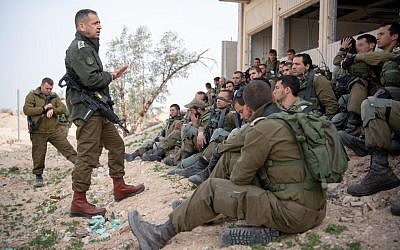 Israel strikes Hamas posts in Gaza after explosive balloon attack
Israel strikes Hamas posts in Gaza after explosive balloon attack
Reprisal comes after airborne explosive device damaged home in Eshkol region earlier in the day
By Judah Ari Gross and TOI staff
27 Feb 2019, 11:55 pm
Israeli jets struck multiple targets in the southern Gaza Strip linked to Hamas late Wednesday, a few hours after an incendiary device from Gaza damaged a home in the Eshkol region.
There were no immediate reports of casualties from the Israeli strikes.
According to Palestinian media reports, several Hamas posts in the southern strip were hit, including one in the Khan Yunis seafront and another outside the city.
Some of the sites hit are believed to belong to Hamas’s Izz ad-Din al-Qassam Brigades, the terror group’s armed wing.
The IDF said the strikes were in response for the “explosive balloons.”
“Our fighter jets and helicopters struck a number of Hamas targets in Gaza in response to the explosive balloons that were launched from Gaza earlier tonight and damaged an Israeli home,” the army said.
The army reiterated its position that it holds Hamas responsible for any violence emanating from the Strip.
A few hours earlier, an explosive device flown into Israel from the Gaza Strip detonatedoutside a home in the Eshkol region, causing damage but no injuries.
The small bomb had been attached to a cluster of balloons and launched toward Israel from the coastal enclave on Wednesday as part of nightly riots along the Gaza border.

Home in the Eshkol Regional Council damaged by an explosive device from Gaza on February 27, 2019. (Eshkol Regional Council)
“A string of balloons carrying an explosive object was spotted traveling from the southern Gaza Strip into Israeli territory. The object apparently exploded in midair and caused damage to a house in a nearby community,” the army said.
Since March 2018, Palestinians in the Gaza Strip have launched thousands of balloons carrying incendiary and explosive devices into Israel, causing wildfires in nearby agricultural fields, forests and nature reserves.
An Israeli policeman watches a fire started by a balloon with attached burning cloth launched by Palestinians from Gaza Strip in Karmia nature reserve park near Israel and Gaza border, Thursday, October 11, 2018. (AP/Tsafrir Abayov)
These arson and bombing attacks largely stopped at the end of last year, in light of a de facto ceasefire between Israel and the Gaza-ruling Hamas terror group, but they returned earlier this month as this understanding began to fray.
Last Tuesday a brush fire in southern Israel was sparked by incendiary balloons from the Gaza Strip.
Wednesday night’s balloon attacks came as hundreds of Palestinians took part in riots along the border of the Gaza Strip near the city of Beit Hanoun.
Demonstrators burned tires, threw rocks and explosives at soldiers and attacked the security fence.













